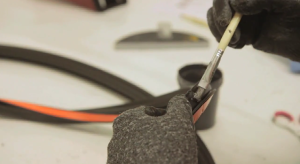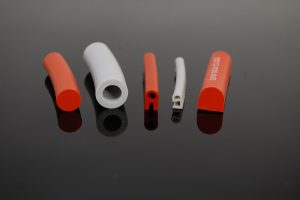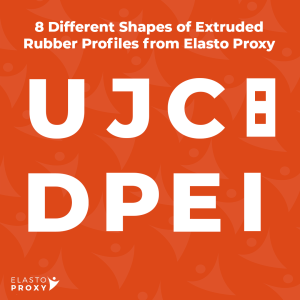 Learn about hot splicing for rubber gaskets, and how vulcanization creates O-rings, door gaskets, window gaskets, and other spliced seals.
Learn about hot splicing for rubber gaskets, and how vulcanization creates O-rings, door gaskets, window gaskets, and other spliced seals.
Hot splicing or vulcanization is a cost-effective joining technique for creating continuous seals or endless gaskets from cut lengths of rubber products. First, a heat-activated adhesive is applied to the ends of sponge or solid profiles. In addition to rectangular profiles, rubber products such as round cords, industrial tubing, and irregularly-shaped rubber profiles can be hot spliced, too.
Next, the ends of the profiles are pressed together and placed in a hot mold or vulcanizing press. The heat activates the rubber-based glue, and pressure from the mold or press creates a reliable, attractive joint for continuous sealing. Proper dwell time is important, and hot spliced gaskets should be stored under controlled conditions in warehouse environments according to standards such as DIN 776 or ISO 2230.
Advantages of Hot Splicing
Hot splicing is one of several different joining techniques that are used with rubber products such as seals, gaskets, and O-Rings. Choosing the right splicing method involves multiple factors, so product designers need to consider the run quantity, material type, and performance considerations. Film splicing, cold bonding, and C-press injection molding all have their strengths, but hot splicing also offers advantages.
For example, hot splicing is a good choice for bonding rubber profiles that do not have an internal cavity. By contrast, C-press injection molding involves the flow of an uncured compound through a cavity where the profiles are under heat and pressure. Vulcanizing is used mainly with small quantities, but is versatile enough to support rubber seals ranging from simple O-rings to multi-sided door gaskets.
Vulcanized Splice Types and Rubber Materials
Gasket fabricators can use hot splicing to create several different types of joints. Butt splices bond two ends of a seal with only limited stress at the splice. Bevel splices are used in cross-sectional areas that don’t allow for butt splicing. Step splices provide maximum bond strength and allow nominal deformation in a static seal. Corner splices are also used in static applications, but when the joint is not under strain.
Gasket fabricators can also produce spliced O-rings and other vulcanized rubber seals from different elastomers. Examples include Buna-N (nitrile), chloroprene, EPDM, fluorocarbon, and silicone. Each rubber compound has specific properties, but also has limitations (such as maximum service temperature). Therefore, it’s important to consider not just the splicing method, but compound selection.
Spliced O-Rings, Endless Gaskets, and Other Sealing Applications
Typically, Elasto Proxy uses vulcanization to produce spliced O-Rings. Additional applications for hot splicing can include door gaskets, window gaskets, and frame and lid gaskets. By listening to all of your requirements and analyzing all of your needs, our solutions providers can determine if hot splicing is the right choice, or if film splicing, cold bonding, or C-press injection molding suit your requirements.
Do you have questions about spliced seals? Do you need vulcanized gaskets that are ready right out-of-the-box for installation in the field or on an assembly line? Please contact Elasto Proxy for more information.











